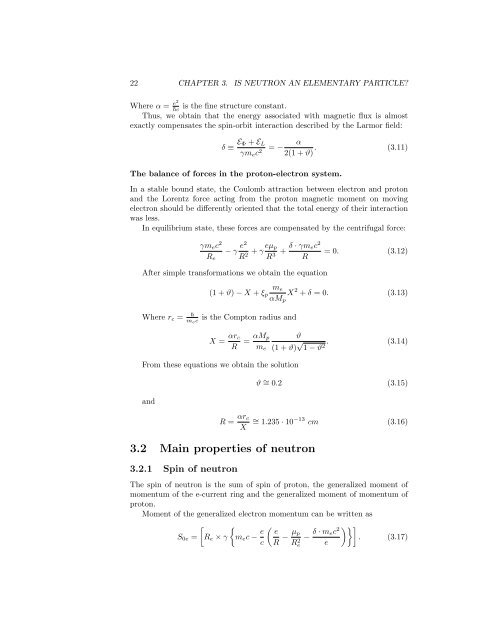VbvNeuE-001
Boris V. Vasiliev About Quantum-Mechanical Nature of Nuclear Forces and Electromagnetic Nature of Neutrinos
Boris V. Vasiliev
About Quantum-Mechanical Nature of Nuclear Forces
and Electromagnetic Nature of Neutrinos
Create successful ePaper yourself
Turn your PDF publications into a flip-book with our unique Google optimized e-Paper software.
22 CHAPTER 3. IS NEUTRON AN ELEMENTARY PARTICLE?<br />
Where α = e2<br />
c<br />
is the fine structure constant.<br />
Thus, we obtain that the energy associated with magnetic flux is almost<br />
exactly compensates the spin-orbit interaction described by the Larmor field:<br />
δ ≡ E Φ + E L<br />
γm e c 2<br />
α<br />
= −<br />
2(1 + ϑ) . (3.11)<br />
The balance of forces in the proton-electron system.<br />
In a stable bound state, the Coulomb attraction between electron and proton<br />
and the Lorentz force acting from the proton magnetic moment on moving<br />
electron should be differently oriented that the total energy of their interaction<br />
was less.<br />
In equilibrium state, these forces are compensated by the centrifugal force:<br />
γm e c 2<br />
R e<br />
− γ e2<br />
R 2 + γ eµ p<br />
R 3 + δ · γm ec 2<br />
= 0. (3.12)<br />
R<br />
After simple transformations we obtain the equation<br />
Where r c =<br />
<br />
m ec<br />
(1 + ϑ) − X + ξ p<br />
m e<br />
αM p<br />
X 2 + δ = 0. (3.13)<br />
is the Compton radius and<br />
X = αr c<br />
R<br />
= αM p<br />
m e<br />
ϑ<br />
(1 + ϑ) √ 1 − ϑ 2 . (3.14)<br />
From these equations we obtain the solution<br />
and<br />
ϑ ∼ = 0.2 (3.15)<br />
R = αr c<br />
X ∼ = 1.235 · 10 −13 cm (3.16)<br />
3.2 Main properties of neutron<br />
3.2.1 Spin of neutron<br />
The spin of neutron is the sum of spin of proton, the generalized moment of<br />
momentum of the e-current ring and the generalized moment of momentum of<br />
proton.<br />
Moment of the generalized electron momentum can be written as<br />
[ {<br />
S 0e = R e × γ m e c − e ( e<br />
c R − µ p<br />
Re<br />
2 − δ · m ec 2 )}]<br />
. (3.17)<br />
e












